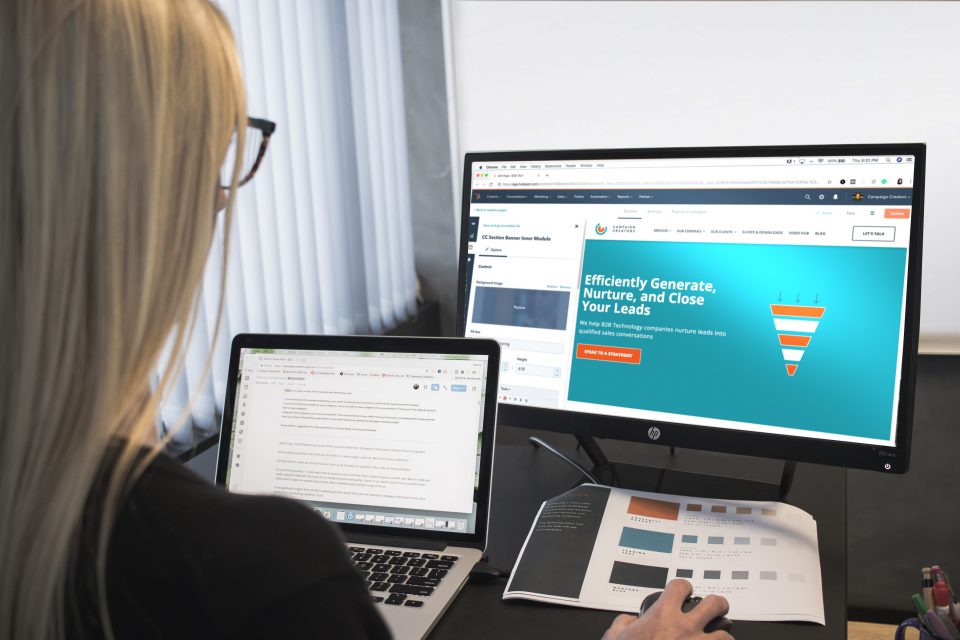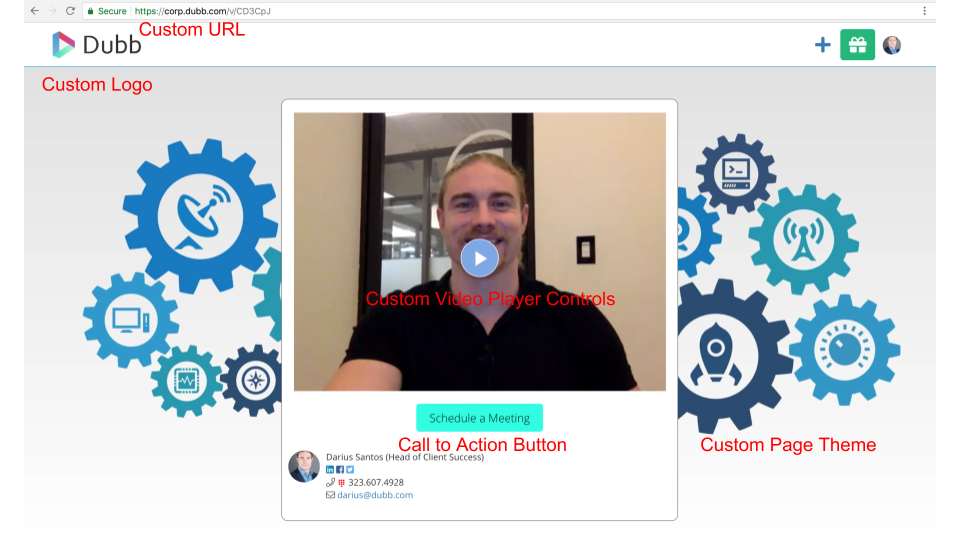Whether you work for a small, young company or established company, you and your marketing team have undoubtedly thought about generating more inbound leads. You may have just started hearing of the term inbound lead generation and are interested in learning more. By contrast, you may have already devoted some time to generating inbound leads, but with mixed results. The customers aren’t quite there yet. You may have a few regulars, but you are ready to leverage an effective, scalable strategy to find new customers.
Ultimately, you should follow your instincts here.
Inbound lead generation can be just the tool that leads to an uptick in leads, subscriptions, or even sales. By bringing people to you, instead of blindly reaching out to potential customers, you can obtain a higher conversion rate and generate more revenue. While there is no free lunch here (inbound lead generation does take time), it is worth spending your time understanding what inbound lead generation is and how you can effectively leverage it at your organization.
If you’re ready to learn, read on!
What Are Inbound Leads?
To start, it is important to understand what inbound leads are and how they differ from outbound leads.
Let’s start with the sibling of inbound lead generation, which is outbound lead generation. The term “outbound” itself (also called a push-based marketing method) refers to a more traditional sales model. Typical outbound activities include phone calls, emails, and door-to-door sales. The objective is for you and your organization to put yourselves out there with the hope that your message appeals to a subset of your targeted audience.
As one simple example, a company may decide to leverage cold calling to find potential customers. The act of going down a list and pushing the company’s message to find a “needle in a haystack” is an example of outbound lead generation.
By contrast, there is inbound marketing.
Inbound marketing methodology relies on bringing customers who are already interested in your product or service. It is about creating original content and having your audience come to you. That original content can be in the form of blog posts, articles, videos on YouTube, and social media posts. Essentially, you can think of it as anything that brings people to your door and through your marketing funnel.
Inbound leads are gathered in a way that the person shows interest in what you’re selling. Once an individual watches or reads your content, you offer them an opportunity to explore more—and potentially purchase your product. You might do this by creating an email list, offering surveys which collect emails on your site, or even through utilizing retargeting.
The value of inbound marketing is that you aren’t searching for that theoretical needle in a haystack. Instead, you are getting higher quality leads. Since the viewer is already interested in what you’re selling there’s a much better chance of closing the sale and creating a customer out of a lead.
There are some significant financial benefits to inbound marketing. The most notable benefit is that inbound marketing costs less per lead than traditional advertising. It is more scalable. This is because inbound marketing does not require as much of a human element compared to outbound marketing tactics. You and your organization don’t need to be making sales calls or sending emails. Instead, you create great content, distribute it to a variety of platforms and channels, and have potential leads come to you.
When these individuals consume your content and follow your call to action (as we will explain below), they are sending a clear message. They are saying, “I want to reach out to this company or this organization because I am interested in their product or service.” They are making that choice—as opposed to a salesperson—which naturally leads to higher conversion rates.
Inbound marketing isn’t perfect, however. It can also be quite a bit slower for a business which isn’t established in its niche. It takes time. If you don’t yet have an audience you may want to consider leading with some outbound marketing to raise awareness. Once you’re an actual presence you can switch your focus to inbound leads and begin pulling an impressive ROI on your advertising.
That said, you should think of inbound marketing as an investment. It requires you and your team to (1) think about which medium to use (we at Dubb prefer video), (2) develop compelling copy, and (3) determine which social channels to use, among other steps.
What Methods Are Used?
With that basic understanding of inbound versus outbound lead generation behind us, let’s move on to discuss several methods used to generate inbound leads.
One of the best things you can do is generate leads through a long-form blog post (somewhere between 2,000 and 3,000 words). It should address every aspect of your ideal customers’ pain points and the problems they want to solve. If you or your team are not comfortable writing this post, you can find great freelancers on marketplaces like Fiverr.
From there, create an ebook out of that blog post—which you can easily do through Google Slides, PowerPoint, or even Microsoft Word. Then you can create a landing page (which we will discuss below) that provides significant value, along with a link to download your ebook (in exchange for their email address). You can also chop up that book and distribute chunks on social media, which will give you more opportunities to collect email addresses.
Now let’s talk about pop-ups on your website.
If you’ve opened a website anytime in the last few years you’ve undoubtedly seen pop-ups asking for your e-mail. Some of these pop-ups that you see take up a huge portion (or the entirety) of the web page and include text like “Provide your email address in the box below to receive our newsletter.” Often, you will click the “X” as quickly as possible and move on.
Pop-ups can be difficult for marketers. However, they aren’t impossible. While many people don’t like full-screen pop-ups, they will engage with more subtle pop-ups. For instance, a bar at the bottom of a user’s screen or dialog in the corner of the screen can help increase conversions. It also builds goodwill, as users are less annoyed about a gigantic pop-up distracting them from your content.
Along with this, pop-ups can be effective if you are offering a deal sweetener to users. In exchange for a user’s email, the business may offer a free product, an ebook on the subject, or just access to a free trial of services. If you’re selling a kitchen appliance, for instance, you can open up with a cookbook showcasing the unique capabilities of your product. Other methods include surveys and access to free trials. Whatever your end method is, the important thing is to offer value to the potential customer to get them to sign up.
Simply put, sweetening the deal is a great way to grow your list. It leverages the power of reciprocity and incentivizes the user to take this extra action. That said, before you can capture their email through a pop-up, you need to develop and release compelling content. There is no way around this.
Once you have a sizable list of inbound leads, it’s time to move to the next step.
What Do I Do With My List?
You sell them things.
However, there is a subtle art to this.
You don’t want to go in guns blazing and immediately start pitching products or services to your list. This is the wrong strategy. When people opt-in or fill out of a form on your website, they are creating a relationship with you that is based on trust. By over spamming or overselling them, you will destroy that trust and lose potential leads.
Instead, you should embrace a stepwise process. You want to continue providing value to those on your email list. Provide educational content and entertain your audience. Bring them into your culture and build strong goodwill with members of your list. The goal is to prove that you are worthy of entering their inbox—even if the recipients already received value by downloading a free ebook or other lead generation magnet.
Email marketing is a tricky subject. If you don’t include any offers then you won’t be able to make a sale but if you overdo it you’re going to be relegated to spam folders and have people dropping like flies.
Instead, you need to come up with a system. If you send one email a week with valuable information, outbound links to good content, and with updates about your business then slipping an offer in each “newsletter” can work well.
Your goal is twofold: keep your subscribers and get them buying.
The Basic Structure of Inbound Marketing
So, now that you know what an inbound lead is and what you’re going to do with your list, it’s time to form a strategy to bring customers in.
The basic building block of any form of digital marketing is the call-to-action (“CTA”). It is an invitation for a reader or user to take a specific action in response to your content. They can include terms like “Download Now,” “Sign Up,” “Make Purchase,” or “Subscribe to Newsletter.” Ultimately, you need to figure out the CTA text that works best for you.
A good CTA leads the customer to perform the action you’ve suggested. Whether that’s a purchase, signing up for your list, or just keeping your bounce rate down by making them browse your blog for extended periods. It makes it extremely simple for users to understand what to do next. A bad one will just irritate your customers.
By creating a strong CTA, you can direct strong leads down your marketing funnel.
The next vital question is where to place your CTA. And while we did discuss pop-ups above, you are not just limited to a pop-up or signup form on your website. Instead, you can guide people to signing up through a variety of channels.
Social media is a great place to begin a list. A quick “sign up for our list” can net a lot of customers if you have interesting content. With Dubb, you can include CTAs directly below videos that you can send through email or text messages.
But no matter where you gather your leads, where are you going to send them? Here, one of the most effective strategies is to leverage custom landing pages.
The Landing Page
Your landing page is an essential part of your inbound lead generation strategy. It is the final destination for your email newsletter, social media content, and guest blog posts. Ultimately, your audience needs to be aware of this landing page. As one simple example, if you have content on Instagram, you need to make it clear that users can click the link in your bio, for example, in order to get to your landing page. On Twitter, place a link to your landing page in a single tweet or at the end of a threaded tweet. On Facebook, you can warm your audience up with quality, original content and then include a link to your landing page in the first comment of your post. In your email newsletter, include a button that leads to your landing page.
This landing page should be your final sell for your product or service. It is where you are making your strongest sell, so include some of your best content there. For instance, think of including your highest-converting video content that explains your product or service. Dubb also allows you to completely customize your landing page, and include as many or as few resources as you like.
However, before you go in for the hard sell, make sure that your leads have received value. People can tell if you are trying to sell them, and often, they turn away from the sale—no matter their interest in your product or service. You need to leverage this subtle art of selling without selling.
Keeping the Strategy Going
Inbound lead generation is all about offering value to customers and potential customers. The more you give, the more you’ll get.
Importantly, you do not want to be stagnant. Keep creating new and interesting content. Switch up your CTAs and create new landing pages. By keeping the train moving (and always placing the audience first), you can keep your audience engaged.
As your inbound lead generation efforts ramp up, you can parlay your content into earned media and paid media. Earned media is when people—on their own accord—post positive things about you and your organization. This can include a tweet, Facebook post, blog post, or something else. By contrast, paid media is when you take your content and sponsor it on social media sites like Facebook, Instagram, YouTube, and Twitter.
The best marketers find a way to balance both earned and paid media. The priority, however, is creating and releasing content that provides significant value to your audience. You can’t really plan for earned media, but once you gain traction (as Wendy’s recently did when bringing back its spicy chicken nuggets), you can discover subtle insights from your audience. In Wendy’s case, it discovered that over two million people wanted the company to bring back this product. This enthusiasm even generated pre-buyers for the company. While Wendy’s perhaps could have discovered this insight through focus groups or market studies, it would have been difficult to discover the amount of enthusiasm for the product without its earned media campaign.
If you’re not a large company like Wendy’s, you can generate earned media by starting small. Reach out to early adopters and encourage them to post about your products or services. The best earned media, however, is organic, so don’t try to force it. However, once early adopters advocate for your product, you can leverage those testimonials into further awareness for your brand.
As for paid media, it can boost your exposure and get more people to look at your content. For example, you can boost a high-converting video or post on Facebook in order to attract even more leads. Data can be your best friend in this whole process, as it helps you optimize your current and future paid media campaigns.
The Holy Grail, however, is not relying too much on paid media. Make awesome, compelling content that people want to naturally share. Through compounding and network effects, your content will organically spread and will generate a significant amount of inbound leads.
Ready to Keep Learning?
Learning to generate inbound leads is just part of the process. It takes time, experience, and a few false starts for most people to begin really succeeding. Ultimately, you want to figure out what’s working and what’s not working. From there, eliminate what isn’t working and double down on what is working. By staying focused and continuing to release compelling content, your inbound lead generation efforts will pay off.
If you’d like to take your inbound lead generation efforts to the next level, we encourage you to check out Dubb. Dubb has a great suite of tools to create videos, landing pages, and CTAs. To learn more, check out our blog by clicking here.


